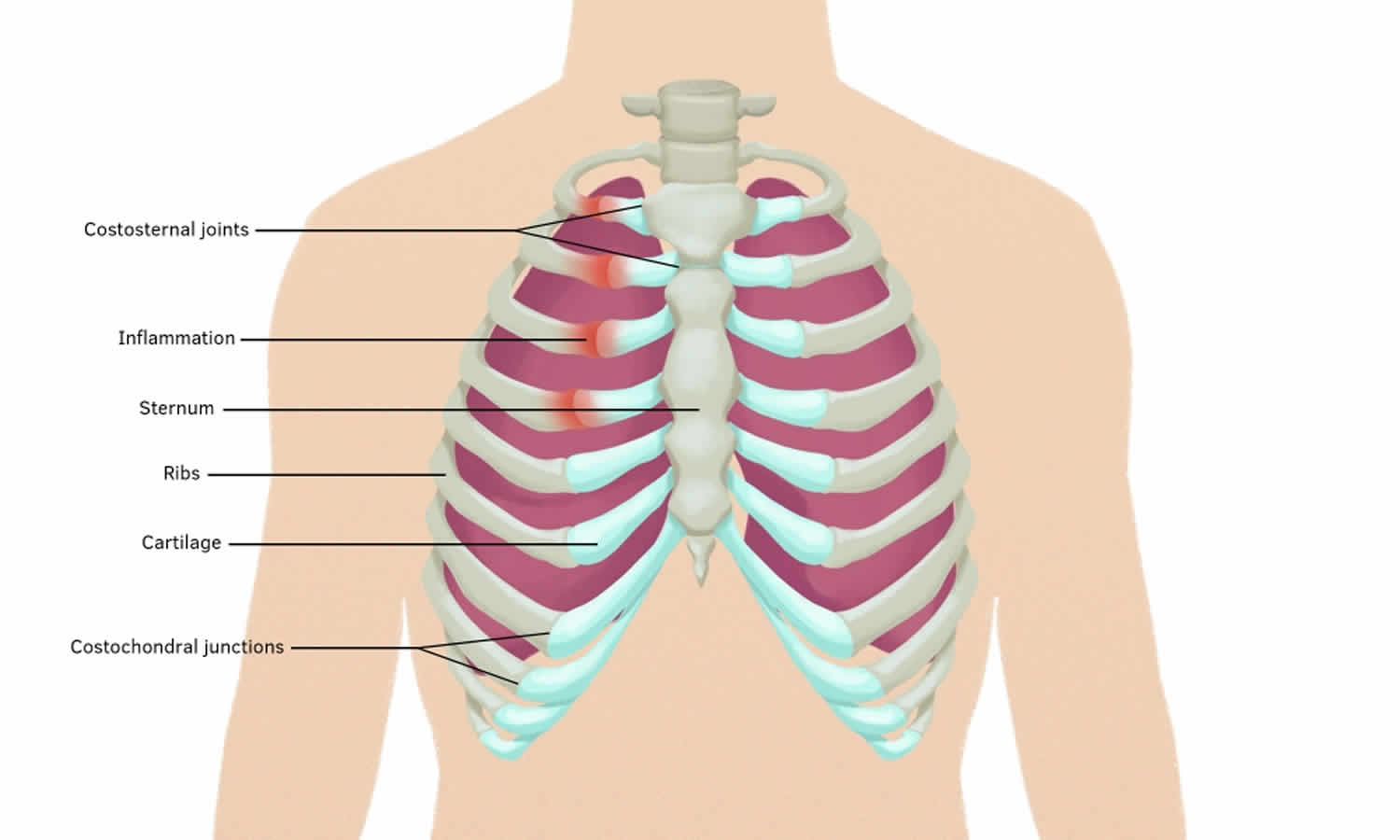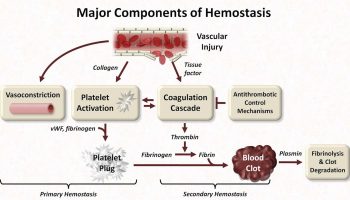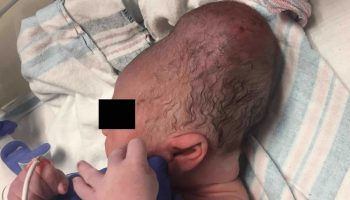Contents
What is Tietze syndrome
Tietze syndrome is a rare inflammatory disorder characterized by chest pain and swelling of the cartilage of one or more of the upper ribs (costochondral junction), specifically where the ribs attach to the breastbone (sternum) 1. Tietze syndrome was first described by Tietze in 1921 as a benign, nonsuppurative painful swelling of the superior chondrosternal joints 2. Tietze syndrome is not the same as costochondritis. Both Tietze syndrome and costochondritis involve inflammation of the costochondral joint and can cause very similar symptoms. However, Tietze’s syndrome is much less common and often causes swelling of the costal cartilages, which does not appear in costochondritis, and the swelling of the costal cartilages may last after any pain and tenderness has gone 3. Like costochondritis, Tietze syndrome was at one time thought to be associated with, or caused by, a viral infection acquired during surgery. This is now known not to be the case, as most sufferers have not had recent surgery. Costochondritis also tends to affect adults aged 40 or over, whereas Tietze’s syndrome usually affects young adults under 40.
Tietze syndrome usually presents in young adults (younger than 40 years), both male and female. Although rare, Tietze syndrome has been reported in infants, children or the elderly. The exact incidence or prevalence of Tietze syndrome is unknown. The cause of Tietze syndrome is not known, but a traumatic pathogenesis cannot be excluded. There is no causal link between Tietze syndrome and profession, ethnicity, or geography; however, clustered cases have been reported. Although the presenting symptoms of Tietze syndrome can mimic numerous pathological causes of chest pain, it is much better characterized as musculoskeletal chest pain 4.
The exact cause is not known. Tietze syndrome was first described in the medical literature in 1921 by Alexander Tietze, a German surgeon 1.
Diagnosing Tietze syndrome is based on exclusion of other, potentially life-threatening, conditions that affect chondrosternal joints, such as rheumatoid arthritis, pyogenic arthritis, and tumors, after careful analysis of case history, physical examination, and results of investigations. In the literature, it is recommended to use radiological evaluation to avoid misdiagnosis 5.
Tietze syndrome is considered a benign syndrome and, in some cases, may resolve itself without treatment. Tietze syndrome is eventually self-limiting; however, it follows a pattern of relapse and remission. The pain can spontaneously disappear after a couple of weeks or can last for months, as does the swelling over the affected joints. Treatment consists of reassurance, avoidance of strenuous activity, applying heat or ice as directed by your doctor and taking pain medications, and/or nonsteroidal anti-inflammatory drugs (NSAIDs) orally. Some people benefit from corticosteroid or lidocaine injections if the pain does not respond to any other treatment.
It can be difficult to tell the difference between the chest pain associated with Tietze syndrome and pain caused by more serious conditions, such as a heart attack.
However, a heart attack usually causes more widespread pain and additional symptoms, such as breathlessness, nausea and sweating.
If you, or someone you’re with, experiences sudden chest pain and you think there’s a possibility it could be a heart attack, dial your local emergency services number immediately and ask for an ambulance.
- If you are in doubt, see your doctor as soon as possible. If you have chest pain and have trouble breathing, feel sick or are sweaty, dial dial your local emergency services number for an ambulance.
If you’ve had chest pain for a while, don’t ignore it. Make an appointment to see your doctor so they can investigate the cause.
How long does Tietze syndrome last?
Usually the pain subsides after several weeks or months, but the palpable swellings may persist for some time. The long-term outlook for people with Tietze syndrome is generally good. Most people are not severely affected by this condition and life expectancy is normal.
Tietze syndrome symptoms
When the costochondral joint becomes inflamed it can result in sharp chest pain and tenderness, which may develop gradually or start suddenly.
The chest pain often gets worse by:
- a particular posture – such as lying down
- putting pressure on your chest – such as wearing a seatbelt or hugging someone
- deep breathing, coughing and sneezing
- physical activity
- if you move
Tietze syndrome is characterized by swelling of the cartilage of the ribs, specifically one of the three ribs that are closest to the head. Most cases of Tietze syndrome have symptoms of pain on one side of the body only (unilateral) and affect only one rib. The affected joint is typically tender and swollen. While the pain associated with Tietze syndrome usually subsides after several weeks or months, the swelling may persist. Some people affected by Tietze syndrome have patterns of relapse and remission, meaning they experience periods of pain and periods when the pain subsides 6.
Tietze syndrome causes
Inflammation is the body’s natural response to infection, irritation or injury.
It’s not known exactly why the costochondral joint becomes inflamed, but in some cases it’s been linked to:
- severe coughing – which strains your chest area
- an injury to your chest
- physical strain from repeated exercise or sudden exertion that you’re not used to – such as moving furniture
- an infection – including respiratory tract infections and wound infections
- wear and tear – your chest moves in and out 20 to 30 times a minute, and over time this motion can lead to discomfort in these joints
Some researchers have speculated that multiple microtrauma to the anterior chest wall may cause the development of Tietze syndrome. Sometimes, the development of the disorder may be preceded by chronic, excessive coughing, vomiting, trauma or impact to the chest, viral or bacterial infections, or surgery to the thoracic area.
Tietze syndrome diagnosis
If you have symptoms of Tietze syndrome, your doctor will examine and touch the upper chest area around your costochondral joint. They’ll ask you when and where your pain occurs and look at your recent medical history.
Before a diagnosis can be confirmed, some tests may need to be carried out to rule out other possible causes of your chest pain.
These may include:
- An electrocardiogram (ECG) – which records the rhythms and electrical activity of your heart
- A blood test to check for signs of underlying inflammation
- A chest X-ray
- Magnetic resonance imaging (MRI) can show thickening and enlargement of affected cartilage.
- Biopsies may be performed to rule out more serious causes of chest pain including malignant conditions.
If no other condition is suspected or found, a diagnosis of Tietze syndrome may be made.
Tietze syndrome treatment
In some cases, pain associated with Tietze syndrome resolves itself without treatment. Specific treatment for individuals with Tietze syndrome consists of rest, avoidance of strenuous activity, the application of heat to the affected area, and pain medications such as nonsteroidal anti-inflammatory drugs (NSAIDs) or a mild pain reliever (analgesic). Local corticosteroid or lidocaine injections directly into the affected area may be beneficial for people who don’t respond to pain relievers (refractory cases). Usually the pain subsides after several weeks or months, but the palpable swellings may persist for some time.
How to get rid of Tietze syndrome
Self-help
Tietze syndrome can be aggravated by any activity that places stress on your chest area, such as strenuous exercise or even simple movements like reaching up to a high cupboard.
Any activity that makes the pain in your chest area worse should be avoided until the inflammation in your ribs and cartilage has improved.
You may also find it soothing to regularly apply heat to the painful area – for example, using a cloth or flannel that’s been warmed with hot water.
Stretching exercises. Gentle stretching exercises for the chest muscles may be helpful.
Painkillers
Painkillers, such as acetaminophen (paracetamol), can be used to ease mild to moderate pain.
Taking a type of medication called a non-steroidal anti-inflammatory drug (NSAID) – such as ibuprofen and naproxen – two or three times a day can also help control the pain and swelling.
Aspirin is also a suitable alternative, but shouldn’t be given to children under 16 years old.
These medications are available from pharmacies without a prescription, but you should make sure you carefully read the instructions that come with them before use.
NSAIDs aren’t suitable for people with certain health conditions, including:
- asthma
- stomach ulcers
- high blood pressure
- kidney or heart problems
Contact your doctor if your symptoms get worse despite resting and taking painkillers, as you may benefit from treatment with corticosteroids.
Corticosteroid injections
Corticosteroids are powerful medicines that can help reduce pain and swelling. They can be injected into and around your costochondral joint to help relieve the symptoms of costochondritis.
Corticosteroid injections may be recommended if your pain is severe, or if NSAIDs are unsuitable or ineffective.
They may be given by your doctor, or you may need to be referred to a specialist called a rheumatologist.
Having too many corticosteroid injections can damage your costochondral joint, so you may only be able to have this type of treatment once every few months if you continue to experience pain.
Transcutaneous electrical nerve stimulation (TENS)
TENS is a method of pain relief where a mild electric current is delivered to the affected area using a small, battery-operated device.
The electrical impulses can reduce the pain signals going to the spinal cord and brain, which may help relieve pain and relax muscles.
They may also stimulate the production of endorphins, which are the body’s natural painkillers.
Although TENS may be used to help relieve pain in a wide range of conditions, it doesn’t work for everyone.
There isn’t enough good-quality scientific evidence to say for sure whether TENS is a reliable method of pain relief. Speak to your doctor if you’re considering TENS.
- Tietze Syndrome. https://rarediseases.org/rare-diseases/tietze-syndrome/[↩][↩]
- Gijsbers E, Knaap SFC. Clinical presentation and chiropractic treatment of Tietze syndrome: A 34-year-old female with left-sided chest pain. Journal of Chiropractic Medicine. 2011;10(1):60-63. doi:10.1016/j.jcm.2010.10.002. https://www.ncbi.nlm.nih.gov/pmc/articles/PMC3110396/[↩]
- Gijsbers E, Knaap SFC. Clinical presentation and chiropractic treatment of Tietze syndrome: A 34-year-old female with left-sided chest pain. Journal of Chiropractic Medicine. 2011;10(1):60-63. doi:10.1016/j.jcm.2010.10.002. https://www.ncbi.nlm.nih.gov/pmc/articles/PMC3110396[↩]
- Musculoskeletal chest wall pain. Fam AG, Smythe HA. CMAJ. 1985 Sep 1; 133(5):379-89. https://www.ncbi.nlm.nih.gov/pmc/articles/PMC1346531/pdf/canmedaj00268-0035.pdf[↩]
- Imaging of sternocostoclavicular joint in spondyloarthropaties and other rheumatic conditions. Guglielmi G, Cascavilla A, Scalzo G, Salaffi F, Grassi W. Clin Exp Rheumatol. 2009 May-Jun; 27(3):402-8.[↩]
- Gijsbers E, Knaap SF. Clinical presentation and chiropractic treatment of Tietze syndrome: A 34-year-old female with left-sided chest pain. J Chiropr Med. March 2011; 10(1):60-63. http://www.ncbi.nlm.nih.gov/pmc/articles/PMC3110396/[↩]





